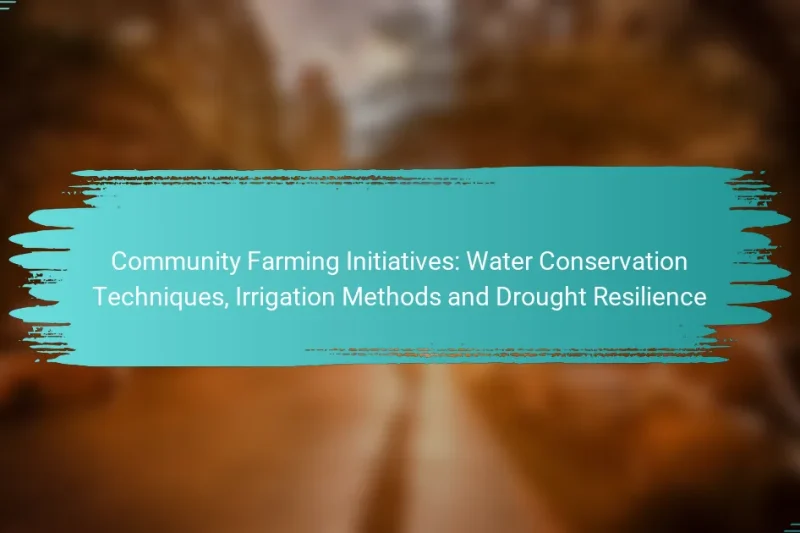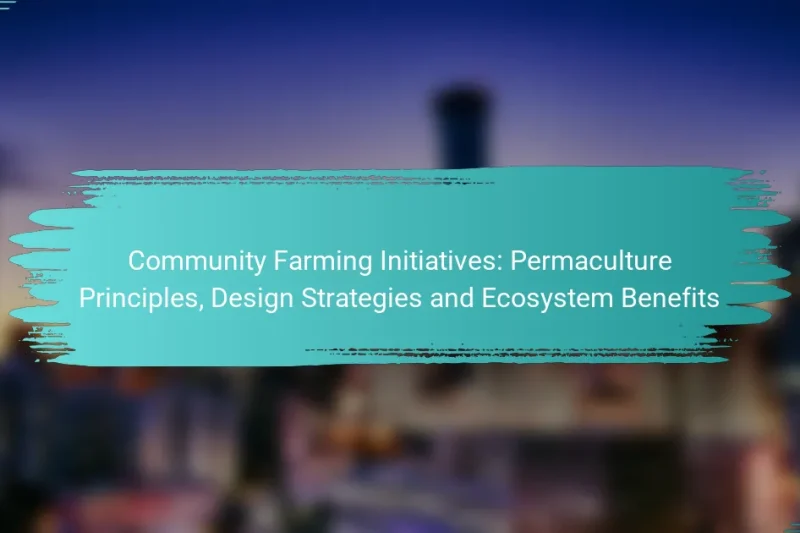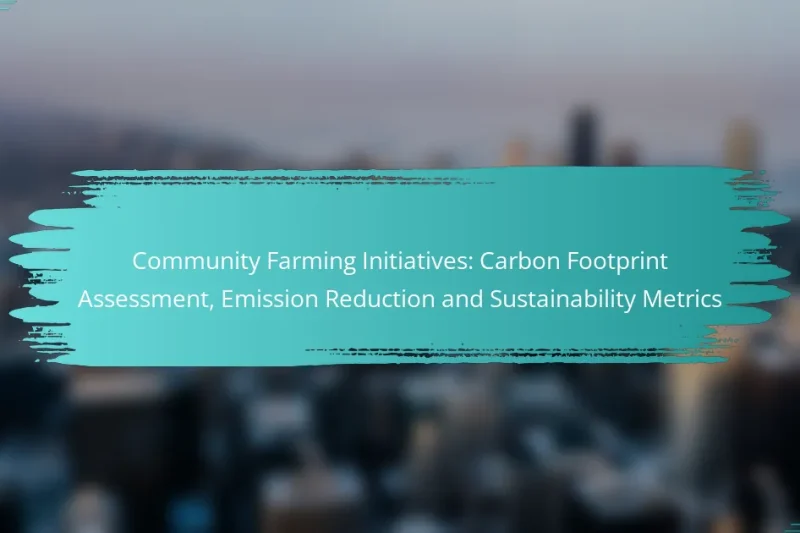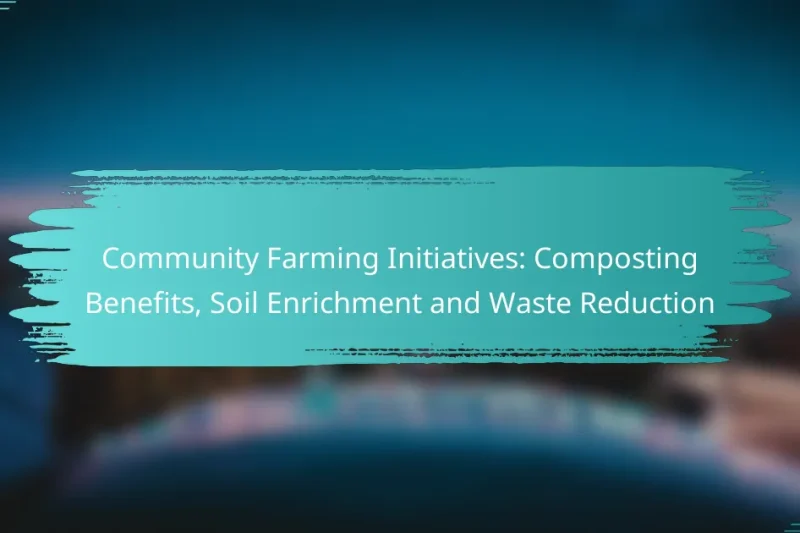Community farming initiatives play a vital role in enhancing biodiversity by fostering diverse ecosystems that support … Community Farming Initiatives: Biodiversity Creation, Habitat Enhancement and Crop VarietyRead more
Sustainability Practices for Community Farming
Sustainability practices in community farming are essential for promoting environmental health and enhancing food systems. By focusing on soil health, resource conservation, and biodiversity, these practices not only boost crop yields but also create resilient farming ecosystems. Implementing renewable energy solutions further reduces reliance on fossil fuels, fostering economic resilience and social cohesion within communities.
Community Farming Initiatives: Organic Practices, Soil Health and Crop Diversity
Community farming initiatives play a vital role in enhancing soil health and promoting sustainable agricultural practices. … Community Farming Initiatives: Organic Practices, Soil Health and Crop DiversityRead more
Community Farming Initiatives: Water Conservation Techniques, Irrigation Methods and Drought Resilience
Community farming initiatives play a crucial role in promoting water conservation techniques and enhancing drought resilience. … Community Farming Initiatives: Water Conservation Techniques, Irrigation Methods and Drought ResilienceRead more
Community Farming Initiatives: Permaculture Principles, Design Strategies and Ecosystem Benefits
Community farming initiatives play a vital role in urban environments by providing fresh food, fostering social … Community Farming Initiatives: Permaculture Principles, Design Strategies and Ecosystem BenefitsRead more
Community Farming Initiatives: Carbon Footprint Assessment, Emission Reduction and Sustainability Metrics
Community farming initiatives play a crucial role in assessing and reducing carbon footprints through sustainable agricultural … Community Farming Initiatives: Carbon Footprint Assessment, Emission Reduction and Sustainability MetricsRead more
Community Farming Initiatives: Composting Benefits, Soil Enrichment and Waste Reduction
Community farming initiatives are vital in promoting composting as a sustainable practice in urban areas, engaging … Community Farming Initiatives: Composting Benefits, Soil Enrichment and Waste ReductionRead more
What are effective sustainability practices for community farming?
Effective sustainability practices for community farming focus on enhancing soil health, conserving resources, and promoting biodiversity. These practices not only improve crop yields but also foster a resilient farming ecosystem.
Crop rotation
Crop rotation involves alternating the types of crops grown in a particular area across seasons. This practice helps prevent soil depletion, reduces pest and disease buildup, and enhances soil fertility. For instance, rotating legumes with cereals can improve nitrogen levels in the soil.
Farmers should plan rotations based on crop families and their nutrient needs, aiming for a diverse mix that supports soil health. A common rotation might include planting corn, followed by soybeans, and then a cover crop like clover.
Permaculture design
Permaculture design is a holistic approach that mimics natural ecosystems to create sustainable agricultural systems. It emphasizes the interconnection of plants, animals, and the environment, optimizing land use while minimizing waste and resource consumption.
Implementing permaculture involves designing layouts that maximize sunlight, water, and nutrient flow. Techniques such as companion planting, where certain plants benefit each other, can enhance productivity and resilience.
Organic pest management
Organic pest management focuses on controlling pests using natural methods rather than synthetic chemicals. This approach includes practices like introducing beneficial insects, using natural repellents, and employing traps to manage pest populations.
Farmers can enhance their pest management strategies by maintaining biodiversity, which attracts predators that keep pest numbers in check. Regular monitoring and early intervention are key to preventing infestations.
Water conservation techniques
Water conservation techniques are essential for sustainable community farming, especially in areas prone to drought. Methods such as drip irrigation, rainwater harvesting, and mulching help reduce water use while maintaining crop health.
Implementing a drip irrigation system can save significant amounts of water compared to traditional methods, delivering moisture directly to plant roots. Regularly checking for leaks and optimizing irrigation schedules can further enhance water efficiency.
Composting
Composting is the process of recycling organic waste into nutrient-rich soil amendments. This practice reduces waste and enriches soil, promoting healthy plant growth. Community farms can compost kitchen scraps, yard waste, and other organic materials to create valuable compost.
To start composting, maintain a balance of green materials (like food scraps) and brown materials (like dried leaves). Regularly turning the compost pile helps aerate it, speeding up decomposition and ensuring a high-quality end product.
How can community farms implement renewable energy solutions?
Community farms can implement renewable energy solutions by integrating technologies such as solar panels, wind turbines, and biogas production systems. These methods not only reduce reliance on fossil fuels but also lower operational costs and enhance sustainability.
Solar panel installation
Installing solar panels is a practical way for community farms to harness renewable energy. These systems convert sunlight into electricity, which can power farm operations and reduce energy bills. Farms should consider factors such as roof orientation, shading, and local incentives when planning installation.
Community farms can benefit from various financing options, including grants and tax credits, which can offset initial costs. It’s advisable to conduct a site assessment to determine the optimal size and placement of the solar array for maximum efficiency.
Wind turbine usage
Wind turbines can provide a significant source of renewable energy for community farms, especially in areas with consistent wind patterns. These turbines convert wind energy into electricity, which can be used on-site or sold back to the grid. Farms should evaluate local wind speeds and zoning regulations before installation.
Smaller turbines, often referred to as micro-turbines, can be a good option for community farms with limited space. It’s essential to consider the potential noise and visual impact on the surrounding community when selecting turbine models.
Biogas production
Biogas production involves converting organic waste from farm operations into renewable energy. This process not only provides a sustainable energy source but also reduces waste and lowers greenhouse gas emissions. Community farms can use anaerobic digesters to facilitate this conversion.
Farms should assess the types and quantities of organic waste available, such as crop residues or livestock manure, to determine the feasibility of a biogas system. Additionally, understanding local regulations regarding waste management and energy production is crucial for successful implementation.
What are the benefits of sustainable community farming?
Sustainable community farming offers numerous advantages, including improved environmental health, economic resilience, and social cohesion. By adopting sustainable practices, communities can enhance their food systems while fostering a sense of belonging and responsibility among residents.
Improved soil health
Healthy soil is vital for productive farming. Sustainable community farming practices, such as crop rotation, cover cropping, and organic amendments, help maintain soil fertility and structure. These methods can lead to increased nutrient availability and reduced erosion, ensuring long-term agricultural productivity.
Incorporating compost and organic matter can significantly enhance soil microbial activity, which is essential for nutrient cycling. Communities should consider regular soil testing to monitor health and make informed decisions about amendments.
Enhanced biodiversity
Sustainable community farming promotes biodiversity by creating habitats for various species, including beneficial insects, birds, and soil organisms. Diverse ecosystems are more resilient to pests and diseases, reducing the need for chemical interventions.
Practices such as intercropping and permaculture design can foster a variety of plant species, which supports a balanced ecosystem. Community gardens can serve as a refuge for local flora and fauna, enhancing overall environmental health.
Reduced carbon footprint
Community farming can significantly lower carbon emissions by minimizing transportation needs and promoting local food production. By sourcing food from nearby farms, communities reduce the reliance on fossil fuels associated with long-distance transportation.
Implementing practices like agroforestry and no-till farming can further sequester carbon in the soil. Communities should aim to adopt energy-efficient tools and renewable energy sources to enhance sustainability.
Stronger community ties
Sustainable community farming fosters connections among residents, encouraging collaboration and shared responsibility. By working together in community gardens or farms, individuals build relationships and strengthen social networks.
Organizing events such as harvest festivals or workshops can enhance community engagement and education about sustainable practices. These activities not only promote food security but also create a sense of pride and ownership within the community.
What resources are available for community farmers in the United States?
Community farmers in the United States can access various resources to support their sustainable practices. These resources include government grants, local agricultural services, and nonprofit organizations dedicated to agricultural development.
USDA grants and programs
The United States Department of Agriculture (USDA) offers numerous grants and programs aimed at assisting community farmers. These can include funding for sustainable farming practices, conservation efforts, and educational initiatives. Farmers can apply for programs like the Environmental Quality Incentives Program (EQIP) or the Sustainable Agriculture Research and Education (SARE) grants, which provide financial support for innovative projects.
To maximize benefits, community farmers should carefully review eligibility requirements and application deadlines. Many grants require detailed project proposals, so it’s essential to prepare comprehensive documentation that outlines the intended use of funds.
Local agricultural extension services
Local agricultural extension services provide valuable resources and expertise to community farmers. These services, often affiliated with state universities, offer educational programs, workshops, and one-on-one consultations. Farmers can gain insights into best practices, pest management, and soil health, tailored to their specific regional conditions.
Engaging with extension agents can also help farmers stay updated on local regulations and funding opportunities. Regular attendance at workshops can enhance knowledge and foster connections with other local farmers.
Nonprofit organizations
Numerous nonprofit organizations support community farming through grants, training, and advocacy. Organizations like the National Sustainable Agriculture Coalition (NSAC) and local food banks often provide resources for sustainable practices and community engagement. They may offer workshops, networking events, and funding opportunities specifically for small-scale farmers.
Community farmers should explore partnerships with these nonprofits to leverage additional resources and gain access to a broader network of support. Collaborating with nonprofits can also enhance visibility and promote sustainable agriculture initiatives within the community.
What are the challenges of adopting sustainability practices?
Adopting sustainability practices in community farming presents several challenges that can hinder implementation. Key obstacles include initial investment costs, knowledge and training gaps, and market access issues that farmers must navigate to successfully integrate sustainable methods.
Initial investment costs
The initial investment costs for sustainable farming practices can be significant, often requiring farmers to allocate funds for new equipment, organic seeds, or eco-friendly materials. These costs can vary widely depending on the scale of the farm and the specific practices adopted, ranging from a few hundred to several thousand dollars.
Farmers should consider financing options such as grants, loans, or cooperative funding to help mitigate these expenses. Additionally, investing in sustainability can lead to long-term savings through reduced input costs and increased resilience to market fluctuations.
Knowledge and training gaps
Many farmers face knowledge and training gaps when transitioning to sustainable practices. This can include a lack of understanding of organic farming techniques, pest management, or soil health. Access to training programs and resources is crucial for building the necessary skills.
Community workshops, online courses, and mentorship programs can provide valuable education. Farmers should actively seek out local agricultural extension services or nonprofit organizations that offer support in sustainable farming methods.
Market access issues
Market access issues can pose significant challenges for farmers adopting sustainability practices. These may include limited access to local markets, competition with conventional products, and consumer awareness of sustainable options. Farmers often struggle to find buyers willing to pay a premium for sustainably produced goods.
Building relationships with local restaurants, grocery stores, and farmers’ markets can enhance market access. Additionally, participating in community-supported agriculture (CSA) programs can create a direct connection with consumers, helping to establish a loyal customer base for sustainably grown products.
How can community farms measure sustainability success?
Community farms can measure sustainability success through various metrics, including environmental impact, social engagement, and economic viability. Key indicators include soil health, biodiversity, community involvement, and financial performance.
Environmental Impact Assessment
To evaluate environmental impact, community farms should monitor soil quality, water usage, and biodiversity levels. Regular soil testing can reveal nutrient content and contamination, while water usage tracking helps identify conservation opportunities. Biodiversity assessments can include species counts and habitat evaluations.
Social Engagement Metrics
Social engagement can be measured by community participation rates, volunteer hours, and educational outreach effectiveness. Surveys and feedback from community members can provide insights into their satisfaction and involvement. Tracking the number of workshops or events hosted can also indicate social impact.
Economic Viability Analysis
Economic viability can be assessed by analyzing revenue streams, cost management, and financial sustainability. Community farms should track sales from produce, grants, and donations. Comparing operational costs against income can help identify areas for improvement and ensure long-term sustainability.





